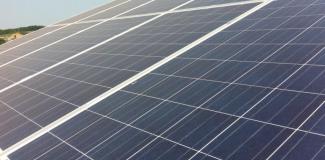Solar (electric) Power

Solar power is produced by conversion of energy from sunlight into electricity, most commonly using photovoltaics (PV) panels.
Photovoltaic panels use silicon to convert solar energy into electric. The PV solar cells act as a semiconductor which absorb sunlight and transfer the energy to negatively charged particles (electrons) that flow through the semiconductor as electrical current.
Introduction
Photovoltaics (PV), or Solar Electric, work by converting the sun's energy into electricity using roof-mounted (most common solution for dwellings) panels. Cheaper units convert just 5 per cent of solar energy into electricity and more efficient, and more expensive units, convert up to 18 per cent of energy received into electricity - panels are continuously developing and improving.
Power output depends on the type of materials used in construction and the amount of sunlight received. The maximum output from PV systems is in the summer, but the maximum power usage in a property is in mid-winter. Energy from these systems can be sold back to the National Grid – note the feed-in tariff (FIT) scheme closed to new applicants from 1 April 2019.
A maximum output energy rating for panels can be misleading and does not relate to the amount of resource (sunlight) that is actually available at any one location. A better way of comparing panels is their % efficiency; this tells you what % of the light landing on them they will turn into electricity. This combined with a figure for the average solar radiation at your site and the size of the panels will give you a far better idea of how much electricity you will generate.
Rule of Thumb
The following are rule of thumb approximations for photovoltaic (PV) panel installations which can be used for preliminary scheme selection.
- 1 kWp photovoltaic array, measuring at least 7.5 m2, will generate ≈750 kWh per year in the UK climate.
- Carbon dioxide savings for 1 kWp will be 480 kgCO2 per year.
- Average power is 20% of peak power, so peak kilowatt of solar array output power corresponds to energy production of 4.8 kWh per day (1 kWp x 24 hours x 20%).
- Expected annual energy yield (kWh) = Panel Efficiency (%) X Average annual solar radiation (kWh per m2) X Area of panels (m2).
- 1 kW Monocrystalline PV solar panels fully installed starts from £3,000 (2022 prices).
- A typical low-energy house will need 3 kWp to 4 kWp capacity.
An installation with an orientation of south 0° and inclination of 35-45° will provide the maximum yield from PV panels.
A message from a sponsor
Photovoltaic Panel Types
The three most common silicon cell types in current use are: monocrystalline; polycrystalline and thin film amorphous silicon.
Monocrystalline (single cell) solar panels are made using cells saw-cut from a single cylindrical crystal of silicon, this is the most efficient of the photovoltaic (PV) technologies. Monocrystalline panels have high efficiencies, typically around 15-20%, although the manufacturing process required to produce mono-crystalline silicon is complicated, resulting in slightly higher costs than other technologies.
Polycrystalline (multi-crystalline) panels are made from cells cut from an ingot of melted and recrystallised silicon. In the manufacturing process, molten silicon is cast into ingots of polycrystalline silicon; these ingots are then saw-cut into very thin wafers and assembled into complete cells. Polycrystalline cells are cheaper to produce than monocrystalline ones. Efficiency of polycrystalline solar panels is only around 12-16%.
Amorphous silicon (thin film) cells are composed of silicon atoms in a thin homogenous layer rather than a crystal structure. Amorphous silicon absorbs light more effectively than crystalline silicon, so the cells can be thinner. Typical efficiency of around thin film solar panels is 6%, but they are easier and therefore cheaper to produce.
1 m2 of monocrystalline or polycrystalline array will provide a useful output of 90–110 kW·h per year, whereas 1 m2 of amorphous thin film array will provide only 30–70 kW·h per year.
Useful Reading
CIBSE: KS15 Capturing Solar Energy
CIBSE: TM25 Understanding building integrated photovoltaics
Factoid
PV panels output is quoted at 25°C, for every 1°C hotter the operating voltage and power will reduce by about 0.5%.
Panels also degrade with efficiency decreasing up to 1% per year.
Solar Irradiance
Solar irradiance measures the power at any particular moment in watts per square meter (W/m2).
The annual UK average mean solar irradiance on a horizontal plane is around 108 W/m2 with an average peak of 200W/m2 in June (SAP version 10.2 Table U3).
Solar Insolation
Solar insolation is the energy received from the sun at a given location over a length of time, usually expressed as kilowatt-hours per square meter (kWh/m2) per annum.
The UK average is around 950 kWh/m2/year.
UK Solar Radiation
Figures from SAP version 10.2 Table U3 indicate the mean solar irradiance on a horizontal plane in southern England is 235 W/m2 in June and 185 W/m2 in the Highlands.
These figures drop to 27 & 12 W/m2 respectively in December.
A message from a sponsor
Solar Electric id: lzc-03 (v.7.0)
